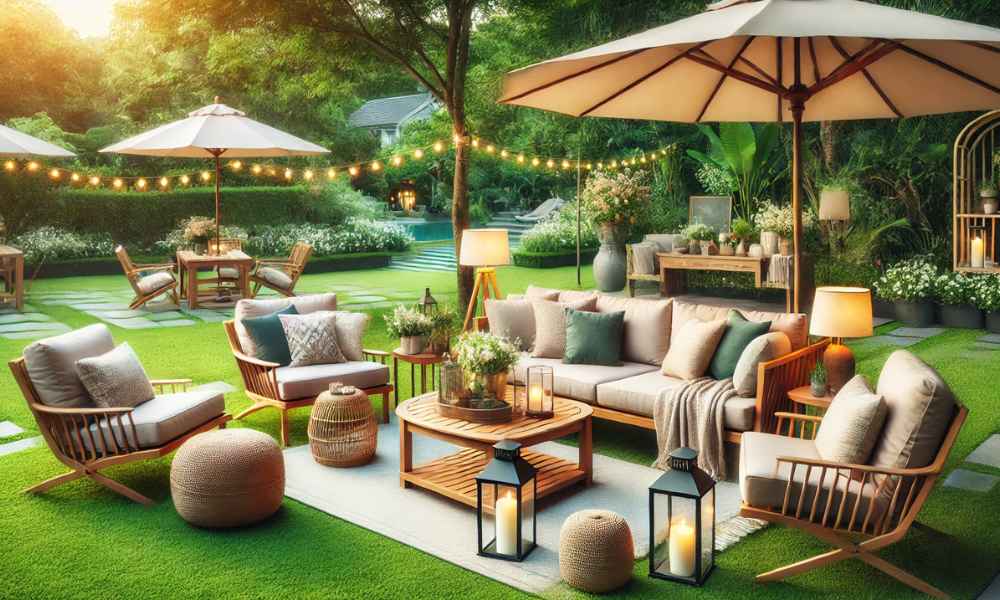There’s something undeniably charming about lounging outdoors, surrounded by nature, with the soft grass beneath your feet. An outdoor seating area on grass is a fantastic way to create a cozy retreat in your backyard, perfect for relaxing with a book, entertaining guests, or simply soaking up the sunshine. Unlike patios or decks, a grass-based seating area is more budget-friendly, requires minimal construction, and blends seamlessly with the landscape. However, setting up a comfortable and durable seating area on grass requires some planning. From choosing the right location to ensuring the grass stays healthy underfoot, every step matters. This guide will walk you through the essentials to help you design an inviting outdoor space that is both practical and aesthetically pleasing.
Choosing the Right Spot for Your Outdoor Seating Area
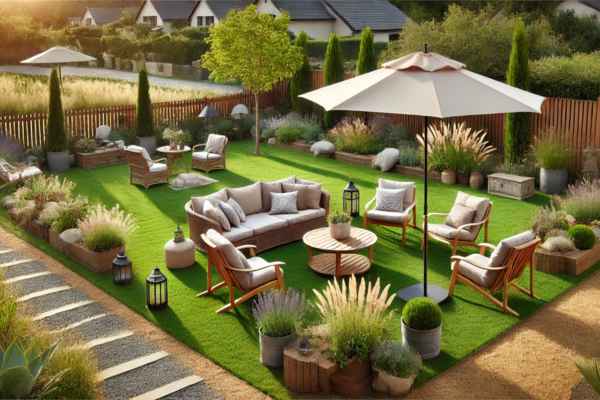
Location is everything when it comes to outdoor seating. You’ll want to find a spot that is both comfortable and functional.
- Sun vs. Shade: Do you enjoy basking in the sun, or do you prefer a cool, shaded retreat? If your yard lacks natural shade, consider placing your seating near a tree or using a shade sail or umbrella.
- Drainage Considerations: Avoid areas that become waterlogged after rain. Grass needs to breathe, and soggy soil will turn your cozy spot into a muddy mess. If necessary, improve drainage by aerating the soil or using porous pavers.
- Accessibility: If you entertain guests frequently, ensure the seating area is easily accessible from the house. A path made of stepping stones or gravel can prevent excessive trampling of the grass.
- Wind Protection: Consider natural windbreaks like shrubs, fences, or hedges to prevent gusts from disrupting your relaxation.
By choosing the right location, you set the foundation for a comfortable and long-lasting outdoor seating area.
Preparing the Grass for a Comfortable Seating Area
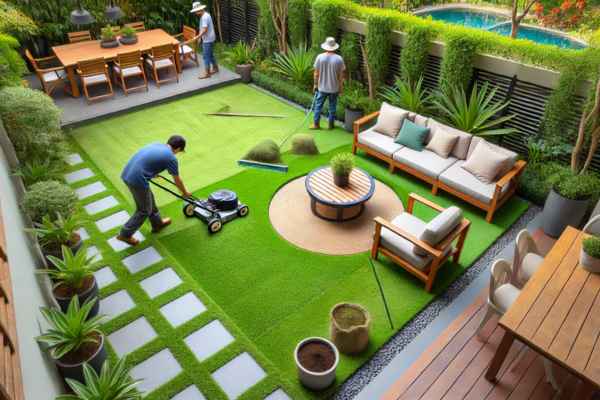
Grass can be a soft, inviting surface, but it needs a bit of preparation to ensure it remains lush and comfortable underfoot.
- Mow and Trim: Start by cutting the grass to a manageable height. Short grass is more resilient and won’t become tangled in furniture legs.
- Level the Ground: Uneven terrain can lead to wobbly seating and discomfort. Use a rake to even out bumps and fill in dips with topsoil.
- Protect Against Wear: Seating areas experience foot traffic, which can lead to patchy, compacted grass. To mitigate this, aerate the soil and consider using an outdoor rug or stepping stones in high-traffic zones.
- Weed Control: Pull out weeds manually or use an eco-friendly weed suppressant to maintain a clean, inviting space.
Once the grass is prepped, it provides a lush and inviting foundation for your seating area.
Selecting the Best Seating for a Grass Surface
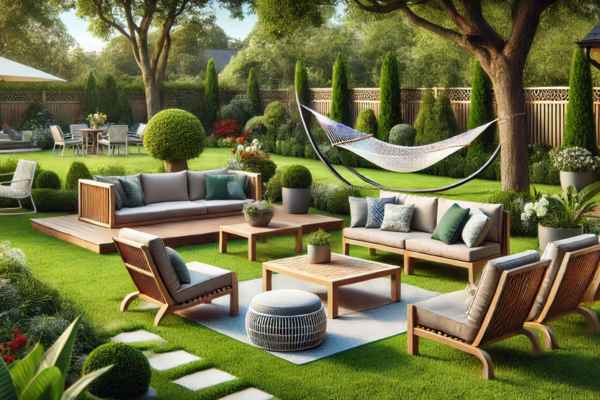
Not all furniture is suited for placement directly on grass. Moisture, uneven surfaces, and sinking legs are potential issues to consider when choosing seating.
- Materials Matter: Opt for weather-resistant materials like treated wood, aluminum, or rattan to prevent rot and rust.
- Stable Base: Avoid furniture with thin legs that may sink into the ground. Wider bases, flat-bottom chairs, or benches are more stable.
- Portable vs. Permanent Seating: Lightweight chairs allow for easy movement, while built-in options like stone benches create a more structured look.
- Hammocks & Lounge Chairs: For ultimate relaxation, consider a hammock or reclining lounge chair with a sturdy frame.
The right seating enhances both comfort and functionality, making your grass area an enjoyable retreat.
DIY or Store-Bought? Choosing the Right Seating Style
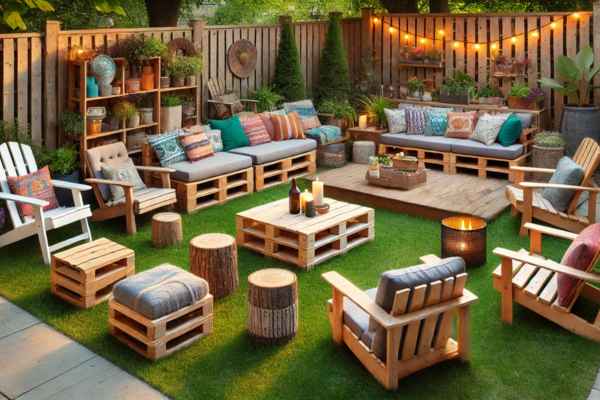
Setting up your outdoor seating area, you can either invest in store-bought furniture or get creative with DIY options.
- DIY Seating Ideas:
- Pallet Benches: Affordable and easy to customize, wooden pallets can be transformed into rustic seating with some cushions.
- Log Stools: If you have access to logs, cutting them into stools adds a natural, earthy feel.
- Repurposed Items: Old tires, cinder blocks, or wooden crates can be upcycled into unique seating options.
- Store-Bought Seating:
- Adirondack Chairs: Sturdy and timeless, perfect for a relaxed vibe.
- Folding Chairs: Great for temporary setups and easy storage.
- Outdoor Sofas: A luxurious option for those wanting a lounge-style area.
Whether you choose DIY or store-bought, ensure the furniture complements your space and is built to withstand the elements.
Adding a Protective Layer: Do You Need a Base?
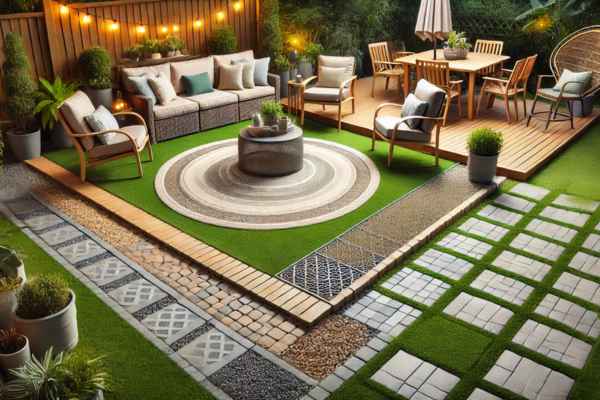
Grass alone may not always be the best surface for a seating area, especially if you want to add a level of protection against moisture and wear.
- Outdoor Rugs: A simple way to define the space while protecting the grass underneath. Choose breathable, mold-resistant rugs designed for outdoor use.
- Pavers or Stepping Stones: Helps prevent furniture from sinking into the grass while adding a stylish touch.
- Gravel or Mulch: These natural ground covers allow for drainage while reducing grass wear and tear.
- Artificial Grass Mats: If maintaining natural grass is a challenge, artificial turf provides a low-maintenance alternative.
Adding a protective layer enhances durability and keeps your seating area looking fresh year-round.
Enhancing Comfort: Cushions, Rugs, and Soft Furnishings
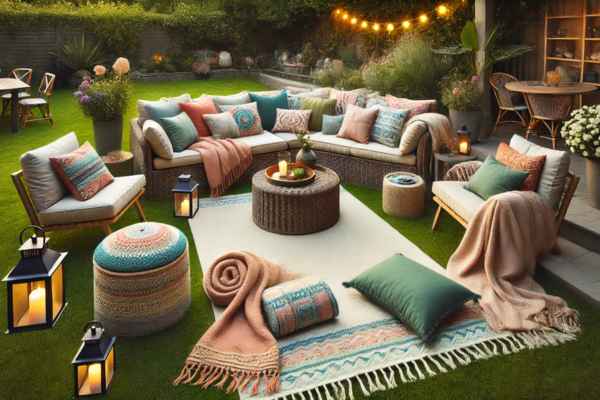
Even with the right seating, additional elements can boost the coziness of your outdoor area.
- Cushions & Throw Pillows: Invest in water-resistant, fade-proof cushions to add comfort and style.
- Outdoor Rugs: Defines the seating area and prevents direct contact with damp grass.
- Blankets & Throws: Ideal for chilly evenings, adding warmth and a touch of homey charm.
- Storage Solutions: Keep soft furnishings dry and fresh by storing them in waterproof outdoor bins or deck boxes.
These small additions make a significant difference, turning your grass seating area into a cozy, inviting retreat.
Creating Shade and Shelter for Your Seating Area
To make your outdoor seating area enjoyable throughout the day, shade is essential. Direct sunlight can make your space uncomfortably warm, while unexpected rain can disrupt your relaxation. If your chosen spot lacks natural shade from trees, consider installing a shade sail, patio umbrella, or pergola. For a more natural approach, plant climbing vines like wisteria or jasmine along a trellis to create a living canopy. If you want a temporary solution, retractable awnings offer flexibility by providing sun protection when needed. Not only does shade enhance comfort, but it also helps preserve outdoor furniture and cushions from sun damage.
Lighting Up Your Outdoor Seating Area
Proper lighting enhances ambiance and extends the usability of your outdoor seating area into the evening hours. String lights, solar-powered lanterns, and LED pathway lights can create a warm, inviting atmosphere. Hanging fairy lights along trees or a pergola adds a whimsical touch, while lanterns placed strategically around the seating area provide soft illumination. For a more rustic and intimate setting, consider DIY candle holders or fire torches. Functional lighting, such as motion-sensor LED lamps, ensures safety and prevents tripping hazards. Thoughtfully placed lighting not only makes your space functional after sunset but also adds charm and character.
Incorporating a Table or Side Surfaces
A seating area isn’t complete without a place to set down drinks, snacks, or decorative elements. Depending on your style and needs, you can incorporate a central coffee table, side tables, or even DIY log stumps as natural accents. If space is limited, opt for folding tables or compact nesting tables that can be stored away when not in use. For a more permanent solution, consider a built-in stone or wooden bench with an attached table. A well-placed table not only adds convenience but also encourages dining and socializing in your outdoor space.
Adding Greenery and Décor for a Cozy Vibe
Bringing in greenery and décor elements enhances the charm of your outdoor seating area while maintaining a natural aesthetic. Potted plants, hanging baskets, and vertical garden walls can add vibrant color and freshness. Incorporate herbs like lavender or rosemary for a fragrant atmosphere, or use succulents for a low-maintenance touch. Outdoor rugs, cushions, and throw blankets introduce warmth and comfort, making the space feel more inviting. You can also personalize the area with wind chimes, garden statues, or DIY art pieces to reflect your style. These small details turn a simple seating area into a true backyard retreat.
Protecting Your Outdoor Seating Area from the Elements
Outdoor furniture and décor are constantly exposed to the elements, so taking steps to protect them will ensure longevity. Invest in weather-resistant furniture covers to shield chairs and tables from rain and sun damage. Choose fade-resistant, water-repellent cushions that can withstand varying weather conditions. To prevent water pooling on the grass, consider placing stepping stones, pavers, or a drainage system beneath the furniture. If you live in an area with strong winds, secure lightweight furniture with anchors or choose heavier, wind-resistant materials. Proper protection ensures your outdoor space remains beautiful and functional throughout the seasons.
Entertaining in Your Grass Seating Area
Your outdoor seating area is the perfect spot for entertaining guests, whether it’s a casual brunch, an evening gathering, or a family barbecue. Set up an outdoor dining station, a fire pit, or a portable bar cart to create a welcoming atmosphere. Consider adding a Bluetooth speaker to play background music or a projector for an outdoor movie night. Arrange extra seating options like folding chairs, poufs, or picnic blankets for larger gatherings. The key to successful outdoor entertaining is flexibility—ensuring guests have enough seating, shade, and lighting for a comfortable experience.
Final Touches and Maintenance Tips
Once your outdoor seating area is set up, regular maintenance will keep it in top condition. Mow and aerate the grass frequently to prevent it from becoming patchy underfoot. If furniture is left on the grass for long periods, consider moving it occasionally to allow the grass to breathe. Sweep or hose down outdoor rugs and cushions to remove dirt and debris. For wooden furniture, apply sealants or weatherproofing treatments to prevent rot. Lastly, refresh the space seasonally with new plants, lighting, or decorative accents to keep it feeling fresh and inviting.
Conclusion
Creating an outdoor seating area on grass is an excellent way to extend your living space into nature. With the right combination of shade, lighting, décor, and protection, you can craft a space that is both practical and visually appealing. Whether you’re entertaining guests or enjoying a quiet evening outdoors, a well-planned seating area transforms your backyard into a comfortable, stylish, and functional retreat. By maintaining and periodically updating your setup, you can ensure it remains a favorite spot for relaxation and socializing year-round.
